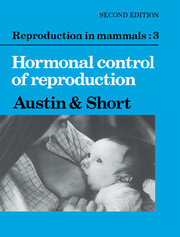Book contents
- Frontmatter
- Contents
- Contributors to Book 3
- Preface to the Second Edition
- Books in the First Edition
- Books in the Second Edition
- 1 The hypothalamus and anterior pituitary gland
- 2 The posterior pituitary
- 3 The pineal gland
- 4 The testis
- 5 The ovary
- 6 Oestrous and menstrual cycles
- 7 Pregnancy
- 8 Lactation
- Index
8 - Lactation
Published online by Cambridge University Press: 05 June 2012
- Frontmatter
- Contents
- Contributors to Book 3
- Preface to the Second Edition
- Books in the First Edition
- Books in the Second Edition
- 1 The hypothalamus and anterior pituitary gland
- 2 The posterior pituitary
- 3 The pineal gland
- 4 The testis
- 5 The ovary
- 6 Oestrous and menstrual cycles
- 7 Pregnancy
- 8 Lactation
- Index
Summary
As the name implies, the mammary gland is the distinguishing feature of mammals. The mammary gland is part of the reproductive apparatus, and lactation is the final phase of reproduction. In most mammals it is an essential phase, and failure to lactate, like failure to ovulate, means failure to reproduce.
Fossil evidence suggests that mammals arose from certain therapsid reptiles some 200 million years ago; unfortunately the soft tissues are usually not preserved in fossils so we do not know when mammary glands first appeared during the course of evolution. Lactation bestowed considerable advantages on the mammalian mother over her viviparous reptilian counterpart, since it ensured an ideal diet for the young after birth; reptiles on the other hand might have had to migrate to special areas where the young could find the type of food that they required. It has even been suggested that the decline of large reptiles at the end of the Mesozoic may have been due to climatic and floral changes that reduced the type of food required by their young. Lactation also permitted birth of an animal with an immature skull and jaws, since teeth are not required for suckling; by the time weaning occurred, and teeth became essential for feeding, the jaws could be sufficiently developed to accommodate a nearly complete set of opposable teeth.
- Type
- Chapter
- Information
- Reproduction in Mammals , pp. 195 - 231Publisher: Cambridge University PressPrint publication year: 1984
- 6
- Cited by



